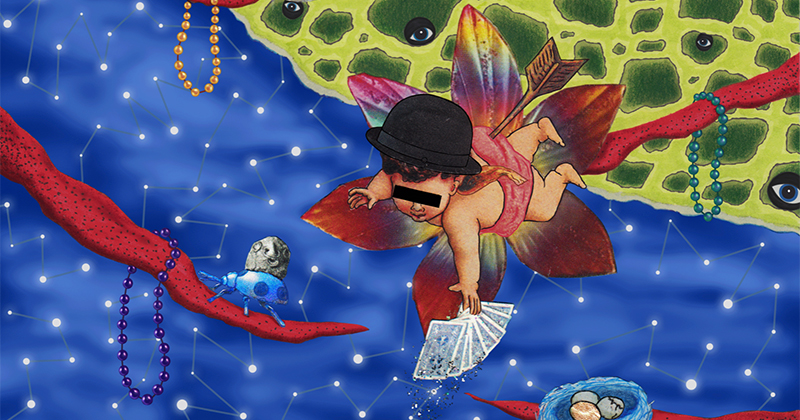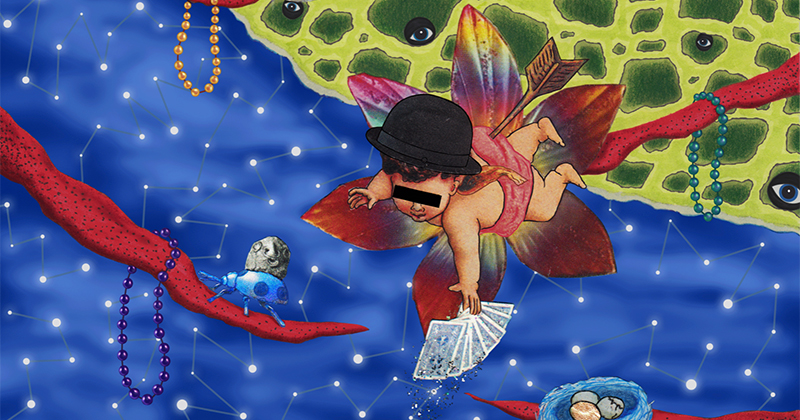Artist and illustrator Drea Aarons was recently named “Artist of the Week at the Co-op,” and with good reason. Her work is both wise and whimsical. And her continued exploration of empty spaces seems particularly germane to our pandemic landscape. Smile Politely sat down with Aarons to learn more about her visual vocabularly, thematic concerns, and, her sources of inspiration.
Smile Politely: First of all, I would like to congratulate you on being selected as Artist of the Week at the Co-op! Let me start by asking you, what is your background, and how did you gain interest in art?
Drea Aarons: Thank you! I can’t really pinpoint when I became interested in art, because in my memory, I always have been. I drew a lot as a child, but I was also into working with polymerclay and paper art. I started out with those Lee. J Ames “Draw 50” books, and the Klutz book that shows you how to make tiny cherry pies and turkeys. As a kid I was constantly daydreaming, so making art was just a tactile manifestation of that. I guess from there it just continued on into art school, and I ended up getting my BFA in Sculpture at the U of I, as well as a certificate in Graphic Design Illustration at Parkland College.
SP: I am intrigued by your work in terms of technique and meaning, and I appreciate the focus of pervasive emptiness. This is a theme I think many can identify with especially now with the pandemic and limited socializing. Would you say this is a personal exploration, a statement of humankind, or perhaps a bit of both? How does your mixed media approach lend itself to convey meaning in your work?
Aarons: I would say that it’s both. My approach is extremely nonlinear, and there’s no real formula, so I’ll do my best to describe it. I typically begin with one (or several) pictures I’ve cut out from books, magazines, or junk mail that I’ve collected—really, anything printed is fair game. The backgrounds of my canvases are hand drawn or painted. When I need a more personal take on a visual element, or a character, I’ll draw it myself, or photograph it. This creates a dynamic between impersonal (found imagery) and personal (created imagery) within the work. Whatever ideas I’ve been chewing on will naturally incorporate themselves into the piece at hand.
SP: You mentioned in your artist statement that you explore “what we choose to fill our lives with, and how those things repeatedly fail us.” In what ways do you think what we choose to fill our emptiness fails us?
Aarons: Last summer I read an excellent book by Jarett Kobek called I Hate The Internet. There’s a passage where he talks about sports, referring to basketball as “creating the illusion of meaning while throwing rubber balls around a rectangular space.” As humans, I think we’re biologically predisposed to create or project meaning on to everything around us. Which is great, but it’s almost like the creation of meaning is what is significant—not the meaning itself. There ends up being a huge disconnect.

Photo of “Inherit.” Photo courtesy of Drea Aarons.
SP: What motivated you to look at the empty spaces, in art and in life?
Aarons: What motivated me initially was my own personal struggle with emptiness—I just felt like I didn’t have the same conviction that I perceived in my peers. While studying I came across the concept of horror vacui, which is where the artist fills the entire canvas, and negative space is just not a thing. Immediately I saw a direct correlation between that, what I was doing in my work, and what we are all collectively doing that masquerades as fulfillment. Life is full of a bunch of junk, and we’re busy pretending otherwise.
SP: Can you please tell us a little about the piece, “constellations // pieces of gaugin” that was selected to be highlighted on the Common Ground Food Co-op website?
Aarons: Sure! “constellations // pieces of gauguin” is the second piece in a three-part series I did, which I refer to as the VOID trilogy. It was an exhausting, intensive process that took about seven years to complete—I don’t know if I’ll ever be doing anything like that again! The recurring eye motif that I use can be a stand-in for a lot of things, but more often than not, it’s fear or paranoia. I think of “constellations” as a party in still life form—it began as a work about a love triangle. The undercurrent of it all being a sense that I was missing out (to avoid using a popular acronym).

Photo of “constellations // pieces of gauguin.” Photo courtesy of Drea Aarons,
SP: I would like to ask you more about your upcoming chapbook, TRASHPOP, inspired by 90s magazines found in your closet. What do you hope to convey from this series?
Aarons: I started TRASHPOP, a six-part series, right around the time lockdown began. As I was cleaning out one of my closets, I found a cardboard box full of alternative rock magazines that had to be from the 00’s. Whenever I find old magazines I sit down, flip through them, and grab what I want. In this particular stack, I found a lot of things that were appealing to me. I had it in my head that I wanted to do a series focusing on how women are portrayed in pop culture, but keep it more minimalistic than the prior work that I’d done. And while I stayed true to that premise in form, the series ended up being a sequence of responses to COVID, and what was going on in my life at the time. It was like I was just operating in pure reaction mode. Like with the torn-up Blue’s Clues doll, seen in “inherit the earth”—the first piece I completed after I was laid off—that piece is about capitalism, and my personal hopes for where we could end up, postpandemic. But this was a year ago, and I think things look a little different now. It’s possible I was just doing that daydreaming thing again… I’m actually not sure at this point when and if TRASHPOP will ever be in book form, although I like the idea of it.
SP: Who are your artist inspirations?
Aarons: This might be the hardest question. I find myself most inspired by the energy and ideas I find in music (I was also briefly a music major!) and novels, although really, any one-person passion project I can find revitalizing. I think I’ve had “Fast Cars” by Connie Constance on repeat since last summer. Right now, I just started reading “my mind is not a billboard,” a poetry chapbook by Sam Pink. I love his writing. It makes sense that we’re talking about books actually, because I’ve destroyed quite a few in the process of making art.
SP: Lastly, what would you like the public to know about you and your art?
Aarons: You can currently see my work in person at The Vault Art Gallery in Tuscola. It will be my first showing since COVID! Otherwise, my work is available online here, and you can follow me on Instagram or Facebook to see what I’m up to.








